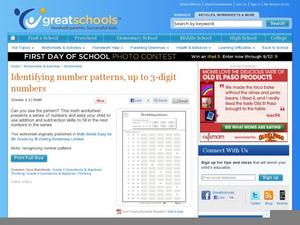Curated OER
Identify Patterns
To complete these number patterns mathematicians must determine by what number each is constantly increasing. However, this isn't your typical skip counting; scholars count by numbers like 18, 60, and even 101 to fill in the missing...
DK Publishing
Different Numbers - Ladybug's Spots
How many spots does this ladybug have? Young counters record the number. Next, they examine three ladybugs, count their spots, and circle the one that has a different number. After repeating this with another set of ladybugs, they can...
Curated OER
Learning 1 - Write the Word
Let's start from the beginning! Young counters complete activities focused on the number one to solidify their understanding of its value. First, they trace its word form and then try it on their own (maybe more than once, even). Next,...
Curated OER
Symmetry
Where is the line of symmetry? Learners begin by drawing in a line to split three images evenly in half, using an example as reference. Encourage them to think about physically folding the picture to solidify this concept. Next, they do...
Curated OER
Long, Longer, Longest
This worm might be long, but can scholars draw an even longer worm? Focus on relative size as they draw a longer worm and then a longer necklace. Next, youngsters examine two sets of objects and check off the longest in an introduction...
Curated OER
The Maze
There's only one way out of this maze, and youngsters will need to use their shape recognition skills to do it! They follow a three-shape pattern all the way from start to finish to keep on track. Encourage them to say the shapes as they...
Curated OER
Most and Least
Which one has the most? Each row has three sets of identical objects, and scholars compare the sets to determine which has the most or the least (they find the most for the first four and the least for the last four). One example is...
Curated OER
Dividing by 3
Use money to practice basic division concepts with young scholars. Each of the seven problems has a set of coins and three empty purses. They add up the coins for a total value and fill in a blank division number sentence to demonstrate...
Curated OER
Ordering Large Numbers: Numbers up to 9,200,000
Once learners understand place value, they can put all kinds of numbers in order - even eight-digit numbers! Fourth graders put groups of five numbers in order from smallest to largest. After they finish, they decipher a word problem and...
Curated OER
Parts of a Set
Calling all fraction novices! Use sets of objects to introduce scholars to fractions before they even have learned about numerators and denominators (but this is a great way to introduce these terms!). The first section has four...
DK Publishing
Part of a Whole
Use segmented shapes to introduce scholars to fractions before they even have learned about numerators and denominators (although this is a great way to introduce these terms!). The first section has four multiple-choice problems:...
Curated OER
Identifying the Patterns
What's the pattern? Preschoolers examine six visual patterns and continue them to the end of the page (drawing). Other than fine motor skills practice, these patterns also help prepare youngsters for letter shapes. You can even point out...
Curated OER
Sorting Sets
Here is a simple sorting activity which is appropriate for pre-k and kindergarten learners. Pupils sort each of four items into the correct group, then count the totals and write the numbers in the boxes provided. Along with being a good...
Curated OER
Times Tables Practice Grids
Warm up your third graders' times table skills with a helpful worksheet. With six grids detailing different times tables, this resource is sure to help even your struggling multiplication learners. Use it as a reference page once kids...
Curated OER
Getting nosy
A nose knows! Connect animals to their noses with a fun science activity. Animals include elephants, rats, pigs, and even humans. For a science exploration, kindergartners answer questions about what they can smell. A great addition to...
Curated OER
Spanish and English Cognates
Discover Spanish cognates. Your learners don't even have to know what common cognates are, to be able to identify the ones used here. First, have them read the Spanish sentence provided. They then choose the correct translation from a...
Curated OER
Soccer - Skeleton Outline
This activity goes directly along with a PowerPoint presentation called - Soccer Notes. You can find it on our Lesson Planet website. The class can take notes on the activity as the teacher shows the PowerPoint and talks about the soccer...
Curated OER
Volleyball - Skeleton Outline
Use this volleyball worksheet in a variety of ways, such as a pre-test, a notetaking worksheet, homework, or a review before a test. It could even be used as a quiz or test. Take a look, and use it to meet the needs of your class.
Curated OER
Cite Right
What do you need to cite, and how can you avoid plagiarizing? This presentation is aimed at beginning writers, and it details some of the ways people plagiarize (even accidentally) and what sort of information needs to be cited. The...
National Endowment for the Humanities
Revolution '67, Lesson 2: What Happened in July 1967? How Do We Know?
Even in a world in which dozens of participants and curious onlookers record every controversial event, the basic facts of what happened are often in dispute. Revolution '67, Lesson 2 explores 1967 Newark, New Jersey using an examination...
Curated OER
Verbals: They look like verbs...but they're not!
Did you know there are three types of verbals? Do you even know what a verbal is? Provide your class with this brief introduction! Participles, infinitives, and gerunds are all introduced, and examples are given. Pair this with a...
SF Environment
Sort and Color!
Sorting is a very important skill that can be used in math and even science. Learners get familiar with some environmentally friendly vocabulary terms as they practice separating objects that can be recycled from those that can't. They...
Physics Classroom
All Work and No Play Lab
Don't let the term, "slotted wood board" detract you from the value of this experiment. Class members tie a string to a cart and, with even horizontal force, drag it up an inclined plane. The objective is to compare the work done with...
Denver Art Museum
Descriptive Haiku
Even though this is technically an art activity, haiku poetry is actually the main focus! Learners view photographs of Japanese tea caddies. They list five descriptive words for the caddies, then write haiku poems using the caddies as...
Other popular searches
- Current Events
- Sequence of Events
- Odd and Even Numbers
- Saturday Evening Post
- Sequencing Events
- Compound Events
- Current Events Newspaper
- Field Day Events
- Chemistry Current Events
- Events
- Current Events Rubric
- Independent Events























